Cedar trees. Useful properties of cedars
Cedar is a tree of the first magnitude. Its usual height is 25 meters. Cones are located exclusively in the upper part of the crown. Their prey is hard physical labor, always fraught with the danger of falling from a tree and breaking their necks. Real “full-size” cedar is hardly suitable for homestead farming. After all, even when grown in full light, the height of an adult plant will be about 20 m, and the area of the horizontal projection of the crown will be more than 100 m2. The relevance of breeding low-growing varieties, which in all other respects would be in no way inferior to ordinary cedar, is obvious.
Natural, “wild” cedar grows relatively slowly, begins to bear fruit at the age of 25-30 years, and reaches its maximum yield (10-15 kg of nuts per tree) at 100-150 years. It is recommended to grow such a cedar only for those who are not in a hurry. An ordinary cedar has a yield, i.e. The mass of a nut per unit area is not that great - no more than 500 kg per hectare. It is known that for many fruit trees, for example, apple trees, varieties have been bred that, despite their relatively slow growth, bear fruit abundantly and have a yield several times higher than that of varieties with a normal growth rate. The question is, why not develop the same varieties of cedar?
The selection of decorative varieties of conifers in the West and Far East has a thousand-year history. Dwarf varieties with unusual crown shape and needle color are considered especially prestigious. All plants used in landscaping have them: pine, spruce, thuja, cypress, juniper and many others. Alas, these varieties were bred in a relatively mild maritime climate. They are of little use even for the European part of Russia, not to mention Siberia. At the same time, Russian conifer species are no different from any others in their genetic polymorphism, therefore, on their basis, it is possible to develop exactly the same wide range of ornamental varieties, which, for all that, will be absolutely stable in our climate. So we set ourselves the task of carrying out this work using the example of Siberian cedar.
All three listed sets of characteristics - slow growth, early and abundant fruiting, unusual shape and structure of the body - are caused by mutations that are harmful “from the point of view” of nature: the genotypes “burdened” by them in natural ecosystems cannot withstand competition with ordinary plants and die. Consequently, in nature it is almost impossible to find a tree that has at least one of the characteristics we need, and then simply propagate it by seeds or grafting. How to be? We use two main methods.
The first is a search in nature not for whole trees, but for their individual branches with interesting and at the same time genotypically determined properties (in scientific terminology - somatic mutations). Yes, this happens, but very, very rarely, in about 1 tree out of several tens of thousands. The second method is controlled crossing of genotypes contrasting in some characteristics, mass cultivation of seed offspring in conditions that exclude competition and natural selection, followed by artificial selection of valuable plants.
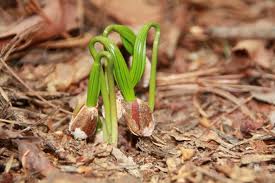 | 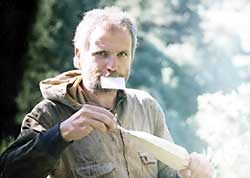 |
Controlled pollination. Natural diversity There are not so many “wild” species. To expand genotypic polymorphism, it is necessary to cross genotypes that are contrasting in geographical origin and properties. On a branch with cones there is a paper insulator, in the teeth there is a bag of tracing paper with pollen, in the right hand there is a pipette - the main tool of the breeder (above) |
|
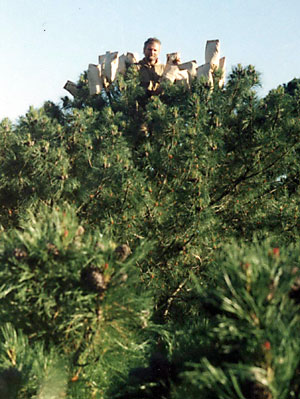 | 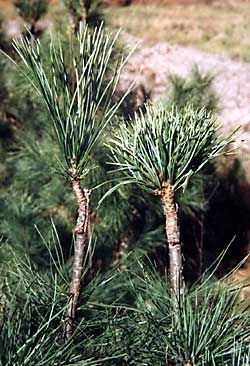 |
From the previous photo it is not noticeable that this is happening at a height of 25 meters from the surface of the earth. Yes, the cones of natural cedar are located exclusively at the top. There is also a breeder’s workplace. The cone cannot be pollinated from below: it is oriented vertically. Therefore, you need to not only climb to the top, but also slightly “soar” above it. Circus + science - this is the formula for success in the selection of forest woody plants. |
Testing of scion varieties. One of the most effective ways- grafting of experimental (right) and control (left) cuttings onto a 2-barrel rootstock. Already a year after vaccination, the differences are visible to the naked eye. In this case, the scion under test is the predecessor of variety 08 "Biosphere". |
We are currently testing hundreds of genotypes obtained in one way or another. For at least several dozen of them, the stability of the selected traits during vegetative propagation can be considered proven. Therefore, these genotypes can be conventionally designated as varieties. The characteristics of varieties consist of several characteristics that are combined differently in each of them:
- the presence of fruiting (fruiting and sterile; the first bear fruit 1-2 years after grafting, the second are bred specifically for landscape design in places where it is not possible to properly protect the plants: alas, hooligans break off the ripening cones along with the branches, or even the entire graft at once );
- abundance of fruiting (all fruiting varieties bear fruit very abundantly, but among them there are “record holders” who, if grafted onto a powerful rootstock, produce one and a half to two dozen cones within a year);
- the size of the cones (large ones are impossible on these varieties; ordinary, small and very small ones are possible, essentially decorative);
- crown density (in all varieties the crown is much denser than that of ordinary cedar, this creates the main decorative effect; however, the differences between varieties are quite large: from super-dense (looks very exotic, but much more difficult to care for) to simply compacted (almost no special care required));
- crown shape (the main shape is spherical, but in some varieties there is a clear tendency towards a cone and a cylinder);
- the color of the needles (most have a normal color, but there are varieties with some tendency towards blue (blue, dove) and yellow.
As you can see, there are many signs. Naturally, not all combinations are possible. For example, varieties with a very dense crown, as a rule, bear little fruit or are completely sterile, etc. However, you will agree that there are some options to choose from.
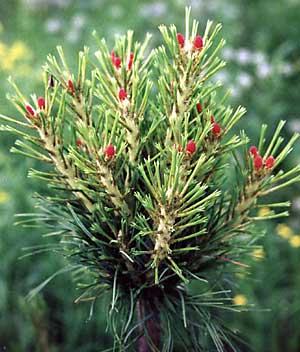 | 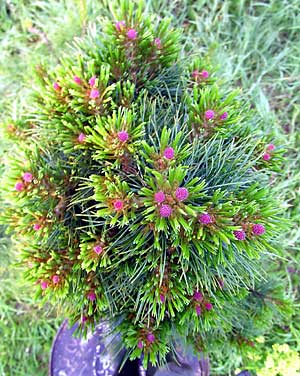 |
||
Variety 032 “Recordist”, unique in terms of abundance of fruiting. The picture shows a 1-year-old (!!!) grafting of this variety on a powerful rootstock with 25 cones ready for pollination. Thus, the most abundant production of cones in this variety occurs already in the year of grafting, and the first harvest ripens after approximately 2 years and 4 months. |
The same vaccination after another two years (top view). The number of cones ready for pollination is already measured in many dozens. |
||
 | 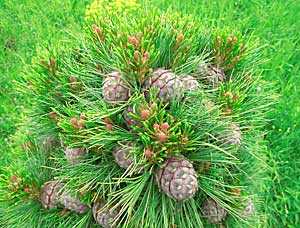 |
||
The same vaccination at the end of May next year. Some of the cones fell off, apparently due to a lack of pollen, but the number of cones that survived, you must agree, is impressive |
The same vaccination after another two weeks. As you can see, the bountiful harvest did not prevent the planting of new cones: their number not only did not decrease compared to last year, on the contrary, it increased significantly |
||
 |  | 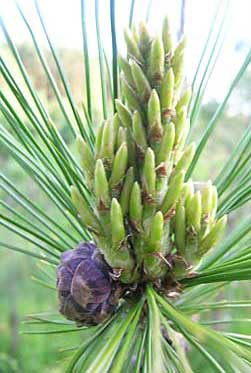 |
|
Variety 02 "President". Rootstock age - 15 years, grafting age - 7 years, height - 50 cm, number of cones - 22 pcs. The picture shows the same plant that two years later was presented on behalf of the Tomsk region to Russian President V.V. Putin for his 50th birthday. There were exactly 50 cones on it |
Variety 03 "Oligarch": a copy prepared for presentation to M.B. Khodorkovsky. Rootstock age - 18 years, grafting age - 9 years, height - 90 cm, number of cones - 18 pcs. Note the asymmetrical shape of the crown | The same variety. Its cones are functionally complete, but small. Their shape is very original. They seem to be flattened: the length of the cone is significantly less than the diameter |
|
The clones in question were simply listed in my test under certain numbers. However, the editors of the magazine "Homestead" (2004, No. 4), which published an article about these varieties, asked me to give each of them its own name. This task turned out to be very difficult, especially since we wanted to make the names both bright and meaningful. This is what happened in the end. The two oldest clones in terms of the start of testing received names associated with the status of their first owners. For example, Tomsk region gave one of them to Russian President V.V. Putin for his 50th birthday. The other, shortly before his arrest, was handed to the main Russian oligarch at that time, M.B. Khodorkovsky. Some of the varieties received names that directly or allegorically characterize some of their properties: grace and sterility (Narcissus), upward direction (Icarus), unusual color of needles (Emerald), crown shape (Biosphere, which in translation from ancient Greek simply means “living ball” ), unique productivity (Record), ideal suitability for creating nut-bearing plantations (Plantation), the ability to be guaranteed to die without special care (Kamikaze). Finally, some varieties had to be named after the place where the source material for their breeding was found: Highlander, Subalpine, On-and-Ona (these are not masculine and feminine pronouns, but two rivers in the Western Sayan). In the magazine article, the varieties remained under numbers: the editors, apparently, did not dare to put the names of Putin and Khodorkovsky next to each other. However, it was not in vain that I “steamed”, inventing these names. Let them now act on a par with the numbers.
 | 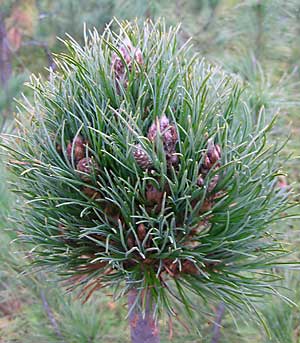 |
Variety 06 "Narcissus". The age of the rootstock is 13 years, the age of grafting is 6 years, the height is 80 cm, there is no fruiting. And next to me is my daughter Margarita |
Variety 034 "Emerald". Combines the original color of the needles, a moderately dense crown and moderately increased fruiting |
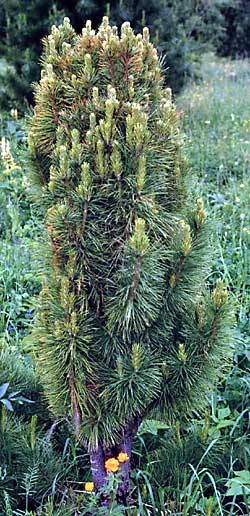 | |
Variety 014 "Icarus". Rootstock age 20 years, grafting age - 11 years, height 150 cm, no fruiting |
Variety 014 "Icarus". The age of the rootstock is 9 years, the grafting age is 1 year. Pay attention to the clear manifestation of the varietal properties of the graft (leader dominance and vertical orientation of shoots) already at such a young age |
The names themselves to some extent demonstrate the diversity of varieties according to their functional purpose. There are varieties of a complex nature; there are those that are especially good as nut-bearing fruits (Recordist, Plantation); There are exclusively decorative ones, ideal for rock gardens and in general for elite landscape design (Narcissus, Biosphere, Emerald); there are very promising ones for bonsai culture (President, Oligarch, Highlander). Below is a table - the characteristics of some varieties in comparison with ordinary cedar (wild species), where possible - in % of it).
| Variety | Speed growth | Presence and abundance of fruiting | Cone size | Density crowns | Crown shape | Needle length | Needle color |
| 02. President | 30 | 500 | 80 | 400 | Cone | 70 | Ordinary |
| 03. Oligarch | 25 | 750 | 50 | 500 | Cone | 70 | Ordinary |
| 06. Narcissus | 20 | 10 | 40 | 900 | Ball | 60 | Bl.-green |
| 08. Biosphere | 35 | 200 | 50 | 600 | Ball | 70 | Ordinary |
| 014. Icarus | 35 | 750 | 40 | 600 | Cylinder | 50 | Bl.-green |
| 020. Subalpine | 40 | 300 | 75 | 300 | Cone | 70 | Gray |
| 032. Record holder | 30 | 1000 | 75 | 600 | Ball | 70 | Ordinary |
| 034. Emerald | 40 | 400 | 65 | 400 | Cone | 70 | Bright green |
| 036. Kamikaze | 25 | 25 | 40 | 1000 | Ball | 60 | Gray |
| 038. He-and- ABOUT on | 50 | 300 | 70 | 200 | Ball | 80 | Ordinary |
| 046. Highlander | 30 | 750 | 70 | 800 | Ball | 60 | Ordinary |
| 054. Plantation | 50 | 400 | 100 | 200 | Ball | 90 | Ordinary |
In addition, slow-growing varieties require special care - removal of oppressed branches from the inside of the crown. Without this, they dry out from lack of light, and dead plant debris accumulates, which can lead to insect pests settling in the crown and damaging living branches. Therefore, at least once every 2 years, and for varieties with a particularly dense crown - annually (best in mid-July, after the end of shoot growth), it is necessary to clear fallen needles from the inside of the crown, and also cut off dry and drying branches facing inward with a sharp knife . It is also useful to slightly thin out the branches in the peripheral part of the crown.
All varieties are suitable for both container culture and open ground cultivation. All of them, bred by methods of intensive (mutational) selection, retain their properties (short stature, decorativeness and scroppiness) almost regardless of the climate (of course, within the forest and forest-steppe zones of the temperate zone). It is known that 10 thousand years ago cedar was distributed in a continuous strip from Western Europe before Eastern Siberia. Some climate warming led to a rupture in its range: cedar survived only in the middle (taiga) zone of the European mountains (Alps, Carpathians) and in Siberia. In the European part of Russia it is not now available only because with modern climatic conditions it could not successfully compete with other trees, mainly Norway spruce, and was gradually replaced by them. However, in cultivation it feels great in most of the forest and forest-steppe zones. This has been proven by many years of experience: there are quite successful plantings not only in the north and in middle lane, but even in the Central Black Earth region. Of course, all the described varieties are quite suitable for use in the European part of Russia. Selection work continues.
Surely many are interested in the question: is it possible to somehow purchase planting material of our varieties? I represent an academic institution. It is quite natural that we are mainly engaged in the search for truth, and not at all in the production of planting material. More precisely, it was so until very recently. We started more or less active propagation of varieties only a couple of years ago. The demand for these plants is huge, and they take a very long time to grow. Therefore, relatively large plants with 5-10 year old grafts are now provided only at the request of the first persons and are used as a present for other first persons. There is also a high and stable interest in young 1-2 year old varietal graftings. These are the same varieties as in the photographs, only young ones. Selling seedlings with young grafts is common for varietal planting material. After all, few people buy an adult apple tree. People take a grafted seedling and grow a fruit tree from it themselves. Information for those interested in purchasing our products will appear on the website around mid-summer, when the young grafts have grown and replanting of plants becomes possible.
Species of the genus Cedar (Cedrus) from the Pine family (Pinaceae) are found in nature in the Mediterranean and Western Himalayas, where they grow in mountain forests at an altitude of 1000-3200 m above sea level. The scientific name of the genus comes from the Greek name for these trees - kedros.
Cedar - majestic and beautiful tree. Compact garden forms of cedars can often be found in rock gardens, while weeping ones can be found on the banks of ponds and in eastern gardens.
The decorative forms of cedars are good in the vicinity of other conifers with rhododendrons, and brightly and abundantly flowering shrubs. Despite the fact that more than 260 years have passed since Linnaeus described the first species of cedar, there is still no consensus among scientists about the number of species in the genus. Some botanists, citing the fact that adult cedars have practically no differences, believe that there is only one species - the Lebanese cedar (Cedrus libani). Other experts identify four different types: Lebanese, Himalayan (Cedrus deodara), Atlas (Cedrus allanfica) and short-coniferous (Cedrus brevifolia).
Three types of cedar
To clarify the situation with cedars, let’s turn to the “Catalog of Life” - an authoritative international project that inventory all known species of plants, fungi, bacteria and animals on the planet. The project's database contains information on 1.6 million species confirmed by international experts (almost 84% of the total diversity known to scientists). So, in the “Catalog of Life” there are three types of cedar; Lebanese, Himalayan and Atlas. This is the most balanced point of view, coinciding with the opinion of the majority of Russian botanists.
Spectacular appearance of cedar
Cedars are large coniferous trees 30-40 m (rarely 60 m) tall. Long, widely spread branches extend horizontally from the trunk, arranged in tiers. The needles are evergreen, 0.8-6 cm long, hard, prickly.
The needles are in bunches of 15-45, on short side shoots their color can be dark or bright green, bluish-bluish.
The cones are barrel-shaped, large (6-12 cm long, 3-8 cm wide), sitting vertically on the branches, resembling candles. Mature cones break down into individual scales, releasing the seeds. The ripening period lasts one year, the seeds are inedible.
It is worth noting that pine nuts, such a popular delicacy in Russia, have nothing to do with real cedars. These are the seeds of the cedar pine, or Siberian pine (Pinus sibirica), which is commonly called Siberian cedar. The seeds of true cedars are inedible.
Our information
It should be noted that pine nuts, such a popular delicacy in Russia, have nothing to do with real cedars. These are the seeds of the cedar pine, or Siberian pine (Pinus sibirica), which is commonly called Siberian cedar. The seeds of true cedars are inedible.
Valuable breed
Since the range of the genus covers the areas where they developed ancient civilizations, cedars have left a noticeable mark on the spiritual and material culture of mankind. They are considered divine trees in Hinduism, the ancient Egyptians used their resin for mummification, cedars received numerous mentions in the Bible and Talmud, in the Sumerian epic. The Phoenicians built ships from their wood, other ancient peoples built palaces and temples, and made religious objects.
Cedar wood is not only beautiful and durable, it has a pleasant smell and bactericidal properties. Things that are stored in cabinets and chests made of cedar are not attacked by moths. In more enlightened eras, much more prosaic things were made from cedar, in particular shoe spreaders, which, among other things, deodorized shoes and boots.
Decorative forms of cedar
Nowadays, there are many decorative forms of cedars. They differ in size (huge trees and dwarf elfin trees), crown shape ( pyramidal, conical, weeping, columnar), length and color of the needles (blue, silver, golden, variegated).
Cedar of Lebanon
Cedar of Lebanon (Cedrus libani) grows naturally in the mountains of Asia Minor. Known in culture since the end of the 17th century. Tree up to 40 m tall, trunk in the lower part up to 2.5 m in diameter.
At an early age, the crown is cone-shaped, gradually becomes spreading with strict branches; in older specimens it can be umbrella-shaped. The needles are dark green or bluish, the needles are up to 3 cm long. The cones are light brown, 8-12 cm long and 4-6 cm in diameter.
Cedar of Lebanon is a beautiful, impressive tree, characterized by slow growth and longevity. The most frost-resistant representative of the genus, tolerates temperatures down to -30 degrees. Light-loving, drought-resistant, undemanding to soil (can grow normally on calcareous substrates).
Atlas cedar
Atlas cedar (Cedrus atlantica) is common in North Africa. Known in cultivation since 1842. The tree is 30-35 m (rarely 40 m) tall and has a trunk diameter of 1.5-2 m. The crown is pyramidal, loose. The needles are bluish-green, up to 3 cm long. The cones are light brown, 9-10 cm long and 4-5 cm in diameter.
In youth it is characterized by rapid growth. Withstands short-term temperature drops down to -20 °C, light-loving, resistant to air pollution and drought. Reacts poorly to the presence of lime in the soil.
Himalayan cedar
Himalayan cedar (C. cleodara) is found naturally in the northwestern Himalayas and Afghanistan. Known in culture since 1822.
Tree up to 40-50 m (sometimes up to 60 m) in height and trunk diameter up to 3 m. The crown is cone-shaped with a pronounced layering of branches, young branches drooping. Mature specimens have a flat crown at the top. The needles are light green or bluish-bluish, up to 5 (sometimes 7) cm long. Cones are 7-13 cm long, 5-9 cm in diameter.
Himalayan cedar grows quickly, is durable, and can reach an age of a thousand years or more. It tolerates shade better than other species of the genus. Requires high air and soil humidity. It can grow on calcareous subarates, although it often suffers from chlorosis. Tolerates frosts down to -25 °C. Not resistant to strong winds. It tolerates haircuts well.
Features of growing cedar
Caring for mature cedars is easy. They need regular monthly feeding with complex mineral fertilizer. In spring and autumn, it is useful to mulch tree trunk circles with nutritious compost.
Young trees should be watered sparingly during prolonged dry and hot periods. It is useful to moisten not only the soil, but also the air: spraying has a very positive effect on the growth and development of young cedars.
A place under the sun
Replanting cedars is contraindicated. It can only be produced at the age of 6-8 years.
The tree is being dug up in early spring, leaving as large a lump of earth as possible on the roots. The planting hole prepared in advance should be 1/3 larger than the root ball. It is useful to add a ready-made soil mixture for coniferous plants, a little forest litter from any coniferous forest, as well as a moderate amount of organic (nutrient compost) and mineral fertilizers. The root collar should remain at soil level. Young plantings are watered abundantly. The distance between copies is at least 3 m.
Winter hardiness
Lebanese and Himalayan cedars tolerate short-term frosts down to -25-30°C. Atlas cedar is less cold-resistant; frosts below -20 °C seriously damage plants. In winter, mature cedars often suffer not so much from frost as from heavy snow, which accumulates on horizontal branches and breaks them off.
Diseases and pests of cedar
Cedars are susceptible to a number of fungal diseases, the most common of which is needle rust. Fungicidal drugs are used for treatment and prevention.
Excess lime in the soil can lead to chlorosis: tree needles turn yellow and branches become bent. The most dangerous pests of this tree species are bark beetles and Hermes Siberian. A tree heavily damaged by bark beetles cannot be saved; it is cut down and destroyed. Insecticidal preparations (decis) are used to control pests.
Cedar propagation
Seed propagation of cedar gives good results. Indoors, sowing is carried out at the end of March - beginning of April, three months before this, stratification begins. The seeds are first soaked for 2-3 hours in potassium permanganate, then filled with hot (40-50 °C) water for 3 days, which is changed daily. Afterwards, the seeds are placed in heavily moistened sand (possibly with a mixture of peat) and kept at a temperature of +4...6 °C. Every two weeks the substrate is mixed and moistened. In spring, the seeds are sown in the ground, covered with a two-centimeter layer of soil.
Cedars in the garden
In ornamental gardening in countries with mild winters, cedars are used quite widely. These majestic trees make impressive alleys and park groups.
Single large specimens with a well-developed symmetrical crown are almost an indispensable component of English estates. One or two powerful trees are planted on the sides of the extensive front lawn, which is located in front of the house. The cedars seem to be enclosed in a frame architectural ensemble, give it, on the one hand, solemnity and grandeur, on the other hand, they introduce a touch of home comfort, enclosing the home with widely spread fluffy branches.
Few people know that Canadian or Siberian cedar, which we have long been accustomed to consider cedars, are not this type of tree and belong to the genera of thuja and pine. And this name was assigned to them because they belong to the same Pine family.
Real cedar is conifer tree the Pine family, the genus of which contains only four species. The height of the trees ranges from 25 to 50 meters, they have a spreading, pyramidal or umbrella-shaped and shallow root system. The needles are collected in bunches, each of which consists of thirty to forty needles, having a three or tetrahedral shape.
The bark is dark gray, the wood is aromatic, and therefore the essential oil of cedar is of extremely high quality, yellowish or reddish in color, resistant to rotting, and due to its strong resin content, insects avoid it.
The cones are single, erect, ovoid or barrel-shaped, have a length of 5 to 10 cm, and a width of about six. They ripen in the second or third year after their appearance, and it is interesting that they do not crumble immediately, but throughout the autumn-winter period. Cedar seeds are triangular in shape, thin-skinned, resinous, 12 to 18 mm long and inedible.
All cedars are heat-loving plants, common in subtropical latitudes, but do not take root in temperate zones (therefore, Russian cedars are actually pine trees). They prefer to grow in mountainous areas, at an altitude of 1.3 to 4 km from sea level next to spruce, fir, pine and other conifers. But it does not tolerate strong sea winds well and almost does not take root on dry calcareous slopes.
In total, the genus of cedars has four species:
- Atlas - has a pyramidal crown, needles of bluish-green or gray color, grows in northwestern Africa, in the Atlas Mountains;
- Lebanese - is a symbol of Libya, depicted on national flag, currently only a few trees remain in the country, which was previously considered the main exporter of timber;
- Himalayan - has a pyramidal shape and thin bluish-green needles, grows in southern Asia, from it, like other trees of the genus, aromatic cedar essential oil is obtained;
- Short-coniferous - has pubescent or bare shoots and shorter dark green needles than other species, can be seen in Cyprus.

Representatives of the pine family
On the territory of Russia, real cedars can only be seen in botanical gardens Caucasus. But cedar pine grows here: the trees known as cedars of Russia are actually pine trees and are represented in the country by three species: Siberian cedar, Korean cedar and cedar.
It is no coincidence that pines are called cedars. According to one legend, Peter I, having returned to Russia from Holland, ordered to find a tree that would not be inferior in properties to cedar, from which the highest quality and strongest ships were built. A similar plant was found in Siberia. It turned out to be pine, which from that moment received a new name - Siberian cedar.
IN natural conditions cedar pine grows in Siberia, the Urals and Altai; in addition, the plant is artificially bred in all corners of Russia: it is very hardy and takes root well in temperate latitudes.
Cedar pine is a coniferous tree with a height of about 40 m and a trunk diameter of about 2 m. Young plants have a pyramidal crown, while in older ones it is wide-spreading and even often has several peaks. The bark is grayish in color and changes color with age: at first young pines are ash-silver in color, then gradually become gray-brown.
The length of the needles is from 5 to 12 cm, they are triangular in pine, dark green in color with a bluish tint, collected in small bunches - from 2 to 5 needles. Ripe cones, from 6 to 13 cm long and about 8 cm wide, are ovoid, light brown in color and contain from 80 to 140 seeds, known to us as pine nuts. The seeds of these cones are edible, very tasty and nutritious.
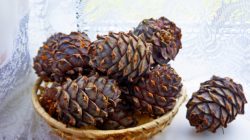
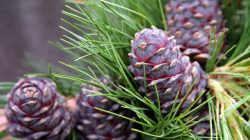
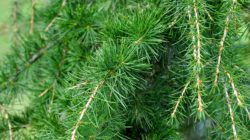
![]()
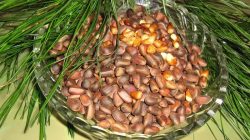


How different real cedars and Siberian pine are from each other is also evidenced by the fact that it is almost impossible to cross them with each other. And even if a tree sprouts, it does not live long and is quickly broken by the wind. This happens primarily at different growth rates: in the first few years, Russian cedars grow in height, while real species grow in thickness. Therefore, at the age of thirty years, the diameter of cedar is 20 cm, pine - 14, which cannot but affect the hybrid tree.
Canadian thujas
Also trees that have nothing to do with real cedars are thujas growing in Canada (many sellers of building materials often deceive buyers in this matter):
Canadian red cedar is actually a arborvitae from the cypress family. The tree has become popular thanks to its wood, which is characterized by durable properties in use. Canadian red cedar is also an ornamental plant: from more tall plants alleys are arranged, dwarf plants are planted in rocky areas.
White Canadian cedar - it is more correct to call the plant thuja occidentalis. The height ranges from 12 to 20 meters, has a compact ovoid or pyramidal shape and is similar in appearance to other members of the cypress family. The wood of the tree is reddish in color, it is characterized by such properties as strength, pleasant aroma, and since it is not subject to rotting, people have found use for it in various fields of activity.
Usage
People have long noticed the beneficial properties of cedar wood and found it used in all spheres of human activity: houses, furniture and other wooden crafts are made from wood. Russian cedars are also used in medicine and cooking: food is prepared from the seeds, cedar vegetable oil is used, medicinal decoctions and cedar essential oil are prepared from pine bark and oleoresin.
Oil
Cedar oil is so unique that there is no oil equal to it in terms of its properties. Pine nut oil is made by pressing the seeds of Siberian pine, and it contains all the beneficial properties inherent in olive, coconut, sea buckthorn and burdock oils. For example, pine nut oil contains five times more vitamin E than olive oil.
Cedar essential oil is obtained both from real wood and from Siberian pine, thuja and other coniferous plants (the properties differ little from each other and the main difference is in the ratio of components).
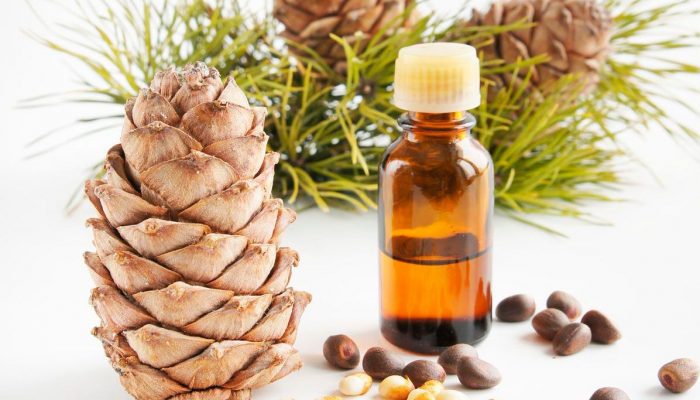
Unlike vegetable oil, cedar essential oil is made from crushed bark, wood, and young shoots. Cedar essential oil has excellent antiseptic, soothing, and antiviral properties; it is successfully used in cosmetology. The only thing is that cedar essential oil is not taken internally: it is inhaled, applied to the skin, and used for healing baths and other procedures.
Sap
Also successfully used in treatment is cedar resin (tree resin), which undergoes pre-treatment: it cannot be used in its pure form, since it hardens quickly.
Basically, cedar resin is also successfully used in solutions that you can either prepare yourself or purchase in a store. It is simple to make: cedar resin dissolves well in any vegetable oil at a temperature of 50 degrees and since the components do not overheat, it does not lose its healing properties and, when used correctly, cures.
Cedar resin is also sold in stores, but the person purchasing the solution should take into account that, most likely, they will buy a fake. For example, a solution called “Turpentine oil” is made from corn and nut oils, and “Turpentine oil” is turpentine turpentine, since it is obtained when cedar oleoresin is distilled with water or steam (in its beneficial properties, such a solution is very different from dissolved in oleoresin oil).
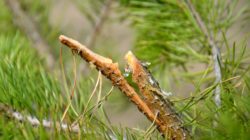
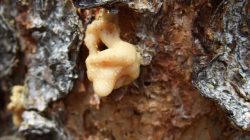




![]()
Seeds
If you figure out what a pine nut is, it turns out that cedar seeds have nothing to do with real nuts, which are the fruits of the nut family. The seeds of true cedar are inedible, but the nuts known to us are the seeds of the cedar pine.
However, this does not at all reduce the beneficial properties of the seeds: they, as well as pine nut oil and tincture made from them, are used in medicine, dietetics, cosmetology, and aromatherapy sessions. For example, pine nuts are often used to improve immunity, vision, and to prevent cardiovascular diseases, atherosclerosis, diabetes, and anemia.
Pine nuts are rich in vitamins A, B, C, D, E, P, and contain great amount minerals, including manganese, copper, magnesium, zinc, iron, phosphorus, iodine. Despite the fact that the pine nut kernel contains a lot of fat, protein and amino acids such as tryptophan, methionine, lysine, it is actively used for weight loss: pine nuts are not only nutritious, but stimulate the activity of the hormone cholecystokinin, which signals the brain about satiety. Pine nut oil made from seeds brings particular benefits to the body.
Pine nut tincture is used not only as alcoholic drink, but also as a treatment for diseases of the musculoskeletal system. Interestingly, in addition to the kernel, pine nut shells are often used to prepare tinctures and balms: the resulting product is an excellent anti-inflammatory medicine.
We must not forget that when talking about pine nuts: benefits and harm go hand in hand. Firstly, if you eat more than 50 g per day, it can harm the body. Also, they should not be consumed together with meat and dairy products, the protein of which interferes with the absorption of food. Pine nuts are not recommended for young children, as they can clog the respiratory tract.
It is necessary to purchase only unpeeled kernels, since when they come into contact with light and oxygen, they go rancid and absorb harmful substances. This means that if the nuts and the dishes that were made from them are bitter, such food should be thrown away, since rancid oil is a strong poison and can take from two days to two weeks to restore the body.
Flower growers have recently begun to pay attention not only to the decorative value of indoor plants, but also to their usefulness in the home. Many people are repulsed by the mere characteristic “the plant is poisonous”. This is especially alarming for those who have small children in the house. Children at a certain age have a habit of trying and tasting everything, and parents take risks by growing poisonous plants in the house.
They are becoming especially popular now. One of the most common conifers is dwarf cedar. The name “cedar” alone inspires respect for this tree. Dwarf cedar in a pot looks very decorative. Presenting a green tree fragrant with freshness and pine aroma for a holiday or just as a gift is considered good manners. Like real cedar or cedar, it releases valuable phytoncides, creating a healing aura around itself. It is very useful for people with weakened immune systems and chronic diseases of the upper respiratory tract to be in a room where dwarf cedar grows.
You can buy dwarf cedar only in a specialized store or nursery. When buying seedlings in a nursery, you may overpay, but you will be sure that this is a dwarf cedar and not a cedar grown from an ordinary cedar seed.
It is possible to grow dwarf cedar from seeds, but again you must be absolutely sure that the seeds are dwarf cedar. The differences between dwarf cedar and Siberian pine are that dwarf cedar has shorter needles, very slowly  grows and has a spherical crown.
grows and has a spherical crown.
Caring for dwarf cedar consists of maintaining the necessary humidity and lighting, feeding and slowing down growth. Seedlings should be planted in early spring. The plant loves light, well-drained soils, moist, but the moisture should not stagnate. Therefore, try not to flood the plant. After planting the seedling, keep it for a month in a shaded place, then you can put it in a more illuminated place, but not in direct sunlight.
Dwarf cedar seedlings reach 1 meter in height by the age of 3. In the third year, cones appear, but they are not yet sufficiently developed and are not suitable for use as planting material.
 In order for the plant to remain small, the pots should not be large, it is necessary to periodically trim the roots and trim the tree. A haircut is actually a gentle plucking of the buds. This will make the cedar branches fluffier and denser. Plucking is done once a year after the needles on the top of the branch begin to separate. It is necessary to trim the roots annually in the spring when changing the soil in the pot. Fertilizing is done as necessary with ordinary mineral fertilizers, depending on the condition of the tree.
In order for the plant to remain small, the pots should not be large, it is necessary to periodically trim the roots and trim the tree. A haircut is actually a gentle plucking of the buds. This will make the cedar branches fluffier and denser. Plucking is done once a year after the needles on the top of the branch begin to separate. It is necessary to trim the roots annually in the spring when changing the soil in the pot. Fertilizing is done as necessary with ordinary mineral fertilizers, depending on the condition of the tree.
After 3 years of age, you can already grow a dwarf cedar yourself from seeds from your own tree. The same can be done with cedar pine. Until a certain period, with proper care, suppressing the development of the root system and the growth of new shoots, the tree will look no less decorative.
